Airborne SAR Radiometric Calibration Based on Improved Sliding Window Integral Method
Abstract
:1. Introduction
2. Study Area and Data
2.1. Experimental Area
2.2. Airborne SAR Data
2.3. Spaceborne SAR Data
3. Methods
3.1. Antenna Pattern Correction
- (a)
- Layout corner reflectors: arrange several trihedral corner reflectors of the same leg length at equal intervals along the range direction, accurately determine the coordinates of the corner reflector positions, and adjust the azimuth and elevation angles required for operation.
- (b)
- Antenna pattern fitting: calculate the response energy of each corner reflector in the SAR image and reconstruct the antenna pattern.
- (c)
- Correction coefficient calculation: calculate the ratio of the peak value on the range direction antenna pattern fitting curve to the fitted value of each pixel as the correction coefficient for each position along the range direction.
- (d)
- Image correction: multiply each pixel in the image range direction by the corresponding correction coefficient to eliminate the radiometric deviation caused by the unknown antenna pattern.
3.2. Point Target Impulse Response Energy Calculation
- A.
- Peak estimation method
- B. Integral method
3.3. Optimal Selection of Center Point
| Algorithm 1: Sliding window method point target center location extraction process. |
| Input: DN: Image amplitude value Coor_plan: Point target initial position X coordinate Size_wind: Buffer size Size_wind: Sliding window size Output: Coor _corr: Coordinates of the point target position corrected using the sliding window method Process: DN_buff = Buffer (DN, Coor_plan, Size_wind) // Buffer Get point target location buffer Sum_wind = 0 for i = 0 to Size_buff-Size_wind do for j = 0 to Size_buff-Size_wind do window = Window(i, j, Size_wind) // Window Get the window corresponding to position i, j if Sum(window)> Sum_wind then // Sum Calculate the sum of pixels in the window Sum_wind = Sum(window) Corr_buff = i, j end if end for end for Coor _corr = Coor_plan-Size_wind/2 + Corr_buff |
3.4. Calibration Constant Calculation
3.5. Radiometric Calibration Accuracy Analysis
- A.
- Relative calibration accuracy
- B. Absolute calibration accuracy
4. Results and Discussion
4.1. Antenna Pattern Correction Evaluation
4.2. Comparative Analysis of Peak Method and Integral Method
4.2.1. Point Target SCR Analysis
4.2.2. Calibration Results and Accuracy Analysis
4.3. Improved Method and Results Based on Sliding Windows
4.3.1. Center Point Optimization Analysis
4.3.2. Calibration Results and Accuracy Analysis
4.4. Cross-Validation Analysis
5. Conclusions
Author Contributions
Funding
Institutional Review Board Statement
Informed Consent Statement
Data Availability Statement
Acknowledgments
Conflicts of Interest
References
- Moreira, A. A golden age for spaceborne SAR systems. In Proceedings of the 2014 20th International Conference on Microwaves, Radar and Wireless Communications (MIKON), Gdansk, Poland, 16–18 June 2014; pp. 1–4. [Google Scholar]
- El-Darymli, K.; McGuire, P.; Gill, E.; Power, D.; Moloney, C. Understanding the significance of radiometric calibration for synthetic aperture radar imagery. In Proceedings of the 2014 IEEE 27th Canadian Conference on Electrical and Computer Engineering (CCECE), Toronto, ON, Canada, 4–7 May 2014; pp. 1–6. [Google Scholar]
- Gray, A.L.; Vachon, P.W.; Livingstone, C.E.; Lukowski, T.I. Synthetic aperture radar calibration using reference reflectors. IEEE Trans. Geosci. Remote Sens. 1990, 28, 374–383. [Google Scholar] [CrossRef]
- Zongmin, F.; Lei, H.; Zhihua, T.; Jiuli, L.; Liangbo, Z. Airborne SAR radiometric calibration using point targets. IOP Conf. Ser. Earth Environ. Sci. 2014, 17, 012186. [Google Scholar] [CrossRef] [Green Version]
- Döring, B.J.; Looser, P.; Jirousek, M.; Schwerdt, M. Point target correction coefficients for absolute SAR calibration. In Proceedings of the 2011 IEEE International Instrumentation and Measurement Technology Conference, Hangzhou, China, 10–12 May 2011; pp. 1–6. [Google Scholar]
- Zhou, Y.; Li, C.; Ma, L.; Yang, M.Y.; Liu, Q. Improved trihedral corner reflector for high-precision SAR calibration and validation. In Proceedings of the 2014 IEEE Geoscience and Remote Sensing Symposium, Quebec City, QC, Canada, 13–18 July 2014; pp. 454–457. [Google Scholar]
- Freeman, A. Sar Calibration: An Overview. IEEE Trans. Geosci. Remote Sens. 1992, 30, 1107–1121. [Google Scholar] [CrossRef]
- Gisinger, C.; Schubert, A.; Breit, H.; Garthwaite, M.; Balss, U.; Willberg, M.; Small, D.; Eineder, M.; Miranda, N. In-Depth Verification of Sentinel-1 and TerraSAR-X Geolocation Accuracy Using the Australian Corner Reflector Array. IEEE Trans. Geosci. Remote Sens. 2021, 59, 1154–1181. [Google Scholar] [CrossRef]
- Chen, J.; Zhang, B.; Wang, C.; Lei, W.; Wu, F. Comparative Study on the Applicability of Two Corner Reflector based Radiometric Calibration Methods for High Resolution Airborne SAR Image. Remote Sens. Technol. Appl. 2015, 30, 677–683. [Google Scholar]
- Zheng, C.; Huang, L.; Chen, Q. Accuracy of Airborne SAR Radiometric Calibration with Point Target. Remote Sens. Inf. 2015, 30, 14–19. [Google Scholar]
- Run, Y. On-Orbit Geometric Calibration of GF-3 Satellite and Joint-Positioning of GF-3 and GF-2 Satellite Images. Master’s Dissertation, WuHan University, Wuhan, China, 2017. [Google Scholar]
- Zhao, R. Research on Model and Method of Geometric Calibration for Space-Borne SAR. Ph.D. Dissertation, Liaoning University of Engineering and Technology, Jinzhou, China, 2017. [Google Scholar]
- Liu, S.J.; Wu, G.Q.; Zhang, X.Z.; Zhang, K.; Wang, P.; Li, Y.M. SAR despeckling via classification-based nonlocal and local sparse representation. Neurocomputing 2017, 219, 174–185. [Google Scholar] [CrossRef]
- Choi, H.; Jeong, J. Speckle Noise Reduction Technique for SAR Images Using Statistical Characteristics of Speckle Noise and Discrete Wavelet Transform. Remote Sens. 2019, 11, 1184. [Google Scholar] [CrossRef] [Green Version]
- Zhu, J.; Ding, C.; Pan, J.; Zhou, L.; Yang, H. Research on System Integration of Airborne Remote Sensing Sensors and MA60 Flight Platform. In Proceedings of the 4th Annual Conference on High Resolution Earth Observation, Wuhan, China, 17 September 2017. [Google Scholar]
- Zhang, G.; Jiang, Y.; Li, L.; Deng, M.; Zhao, R. Research progress of high-resolution optical/SAR satellite geometric radiometric calibration. Acta Geod. Cartogr. Sin. 2019, 48, 1604–1623. [Google Scholar]
- Larson, R.W.; Jackson, P.L.; Kasischke, E.S. A digital calibration method for synthetic aperture radar systems. IEEE Trans. Geosci. Remote Sens. 1988, 26, 753–763. [Google Scholar] [CrossRef]
- Yang, S.; Xu, Z.; Cheng, C. Method of airborne SAR radiation calibration based on point target. In Proceedings of the International Archives of the Photogrammetry, Remote Sensing and Spatial Information Sciences—ISPRS Archives, Online, 14–20 June 2020. [Google Scholar]
- Touzi, R.; Hawkins, R.K.; Cote, S. High-Precision Assessment and Calibration of Polarimetric RADARSAT-2 SAR Using Transponder Measurements. IEEE Trans. Geosci. Remote Sens. 2013, 51, 487–503. [Google Scholar] [CrossRef]
- Ulander, I.M.H. Accuracy of using point targets for SAR calibration. IEEE Trans. Aerosp. Electron. Syst. 1991, 27, 139–148. [Google Scholar] [CrossRef]
- Praveen, T.N.; Raju, M.V.; Vishwanath, B.D.; Meghana, P.; Manjula, T.R.; Raju, G. Absolute radiometric calibration of RISAT-1 SAR image using peak method. In Proceedings of the 2018 3rd IEEE International Conference on Recent Trends in Electronics, Information & Communication Technology (RTEICT), Bangalore, India, 18–19 May 2018; pp. 456–460. [Google Scholar]
- Zink, M.; Bamler, R. X-SAR radiometric calibration and data quality. IEEE Trans. Geosci. Remote Sens. 1995, 33, 840–847. [Google Scholar] [CrossRef]
- Cumming, I.G.; Wong, F.H. Digital Processing of Synthetic Aperture Radar Data Algorithm and Implementation. Artech House 2005, 1, 108–110. [Google Scholar]
- Oliver, C.; Quegan, S. Understanding Synthetic Aperture Radar Images; Artech House: Boston, MA, USA; London, UK, 1998. [Google Scholar]
- Yuan, L.; Li, Z.; Ge, J.; Jiang, K. Research on Approach of SAR Radiometric Calibration Using Point Target. Radio Eng. 2009, 39, 25–28. [Google Scholar]
- Wang, Q.; Zeng, Q.; Jiao, J.; Zhou, X.; Liang, C.; Gao, S. Determination of vertical antenna pattern of high-resolution airborne SAR and radiometric calibration. In Proceedings of the 2012 IEEE International Geoscience and Remote Sensing Symposium, Munich, Germany, 22–27 July 2012; pp. 4022–4025. [Google Scholar]
- Bai, X.; He, B.; Li, X.; Zeng, J.; Wang, X.; Wang, Z.; Zeng, Y.; Su, Z. First assessment of Sentinel-1A data for surface soil moisture estimations using a coupled water cloud model and advanced integral equation model over the Tibetan Plateau. Remote Sens. 2017, 9, 714. [Google Scholar] [CrossRef] [Green Version]
- Ulaby, F.T.; Moore, R.K.; Fung, A.K. Microwave Remote Sensing: Active and Passive, Volume II: Radar Remote Sensing and Surface Scattering and Emission Theory; Artech House Publishers: Norwood, MA, USA, 1986. [Google Scholar]
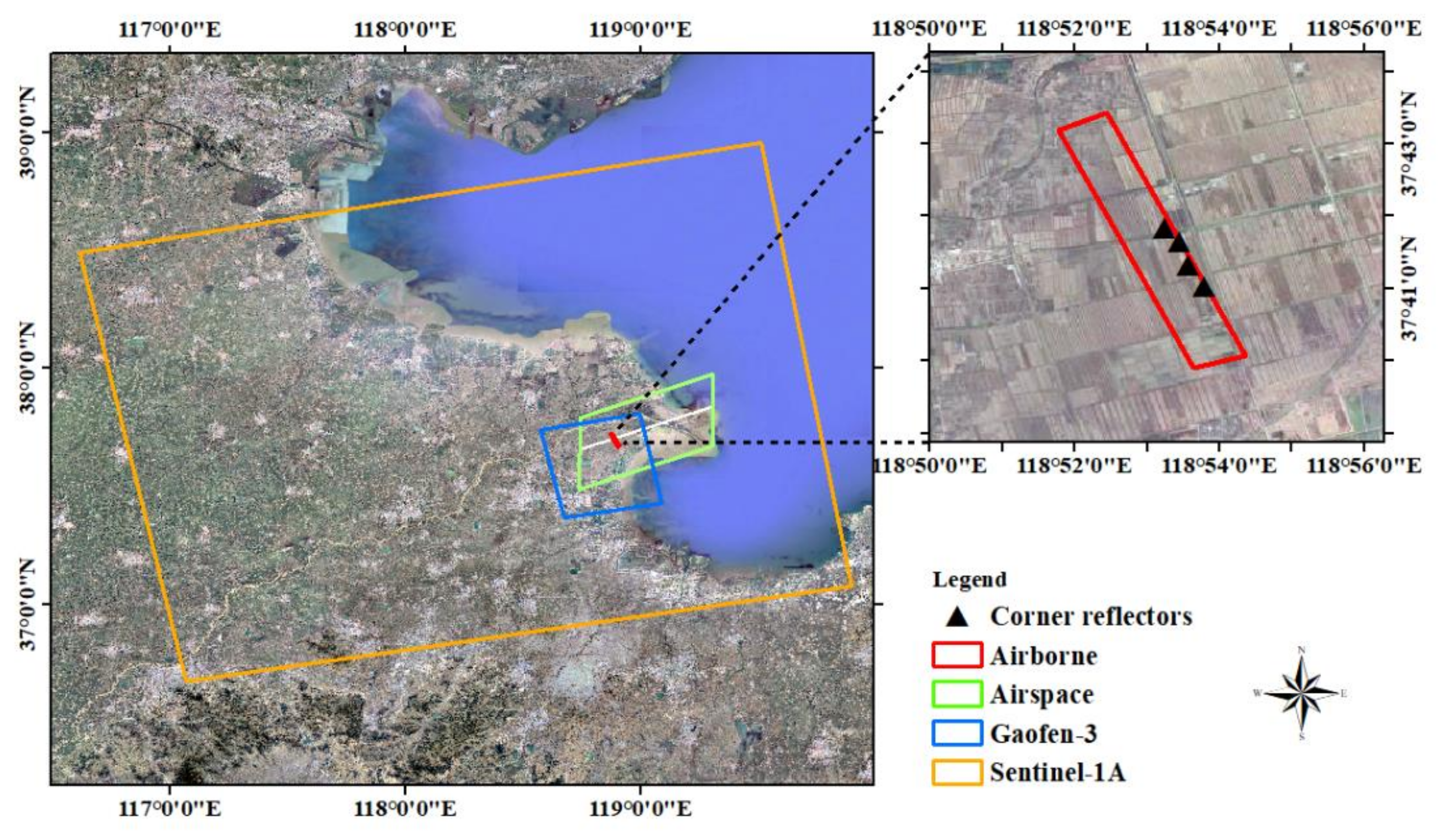

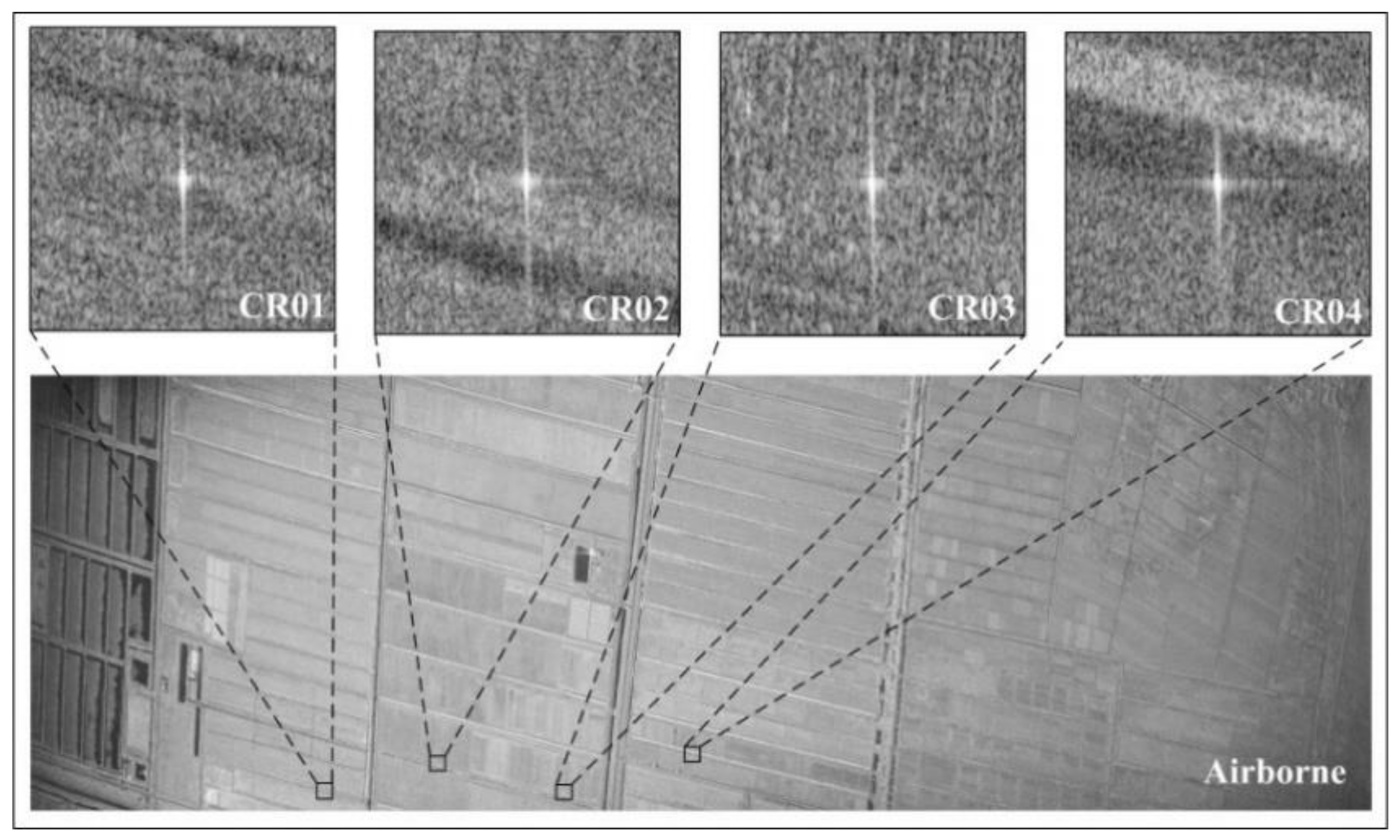
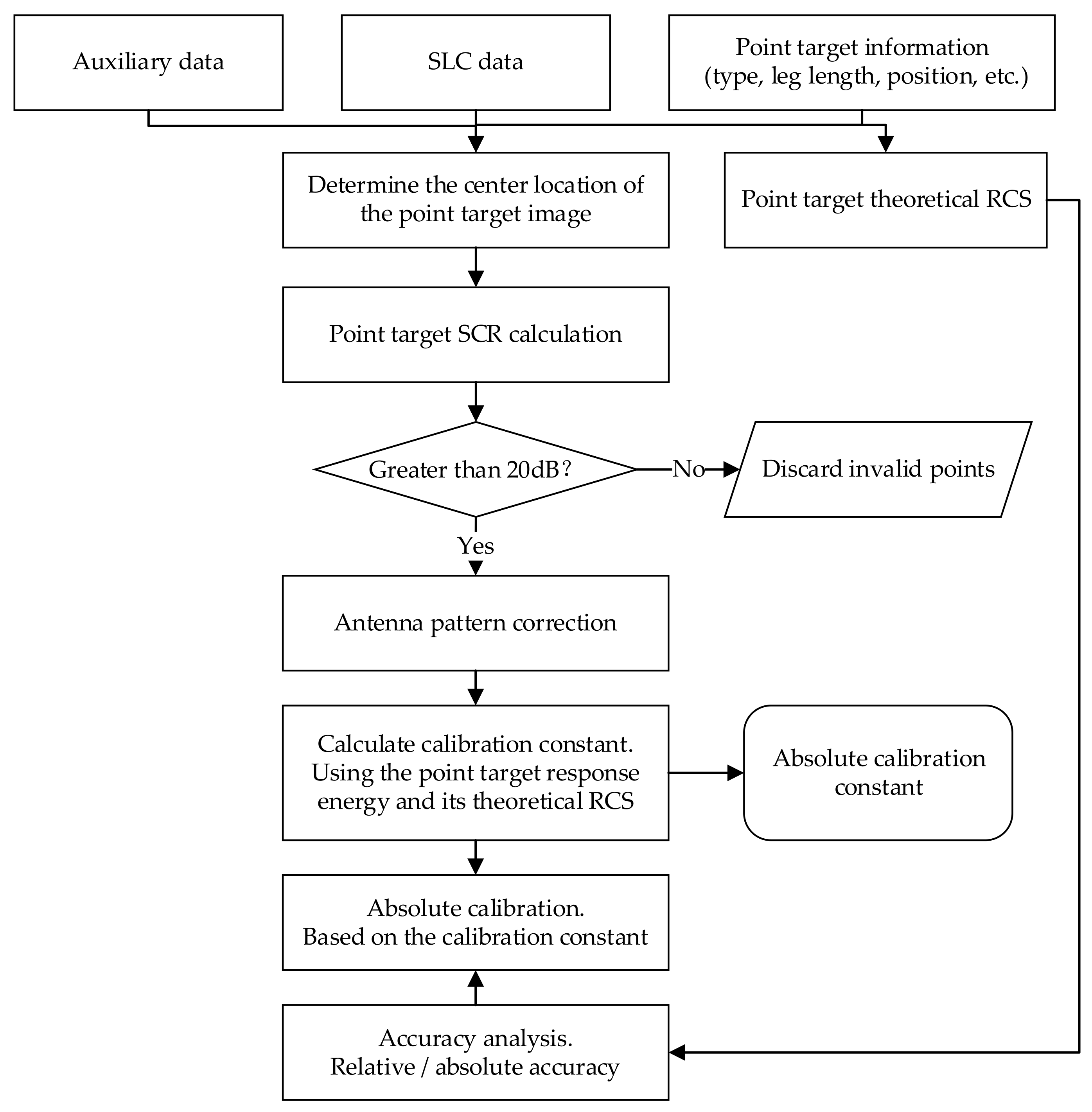

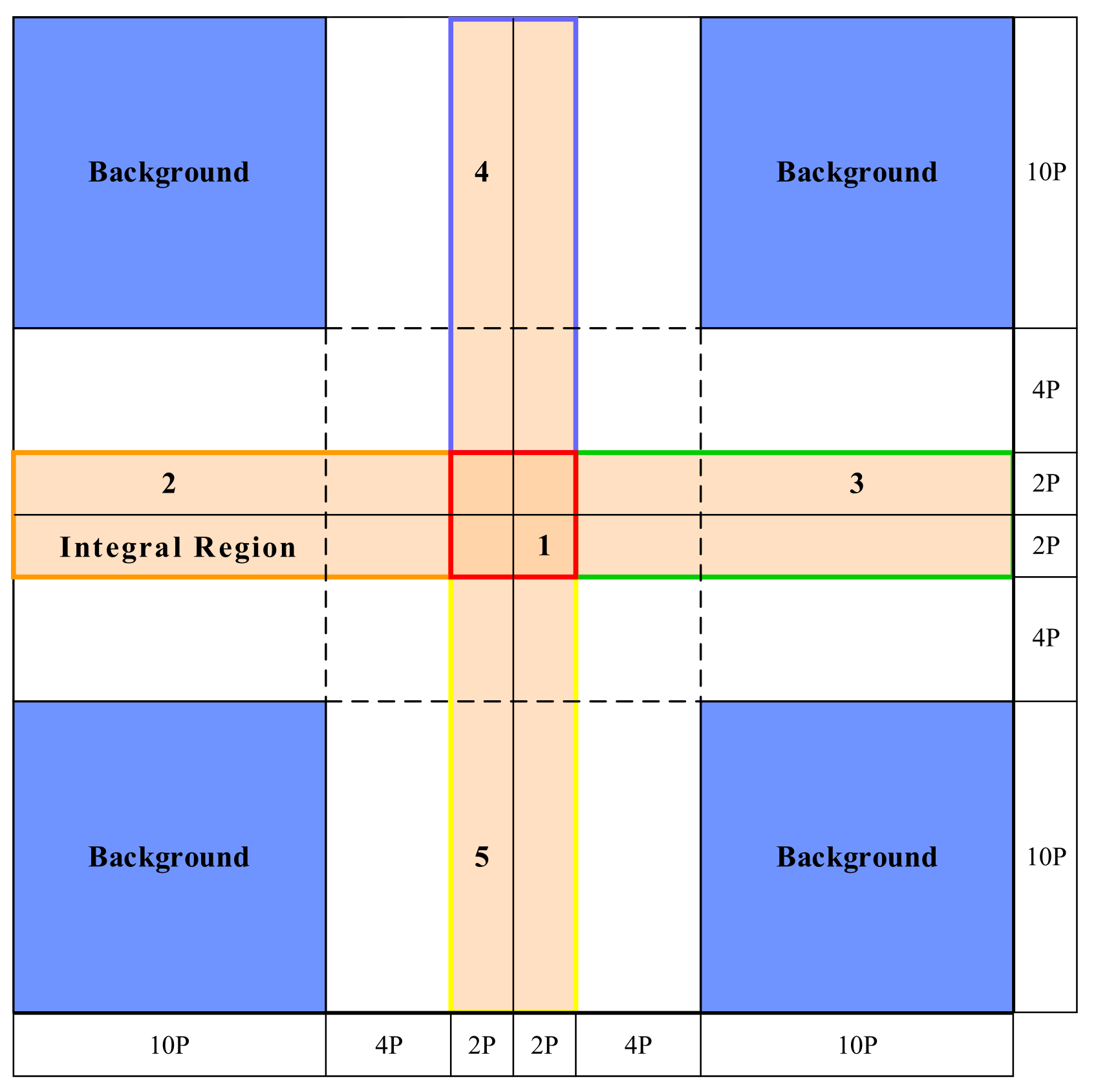



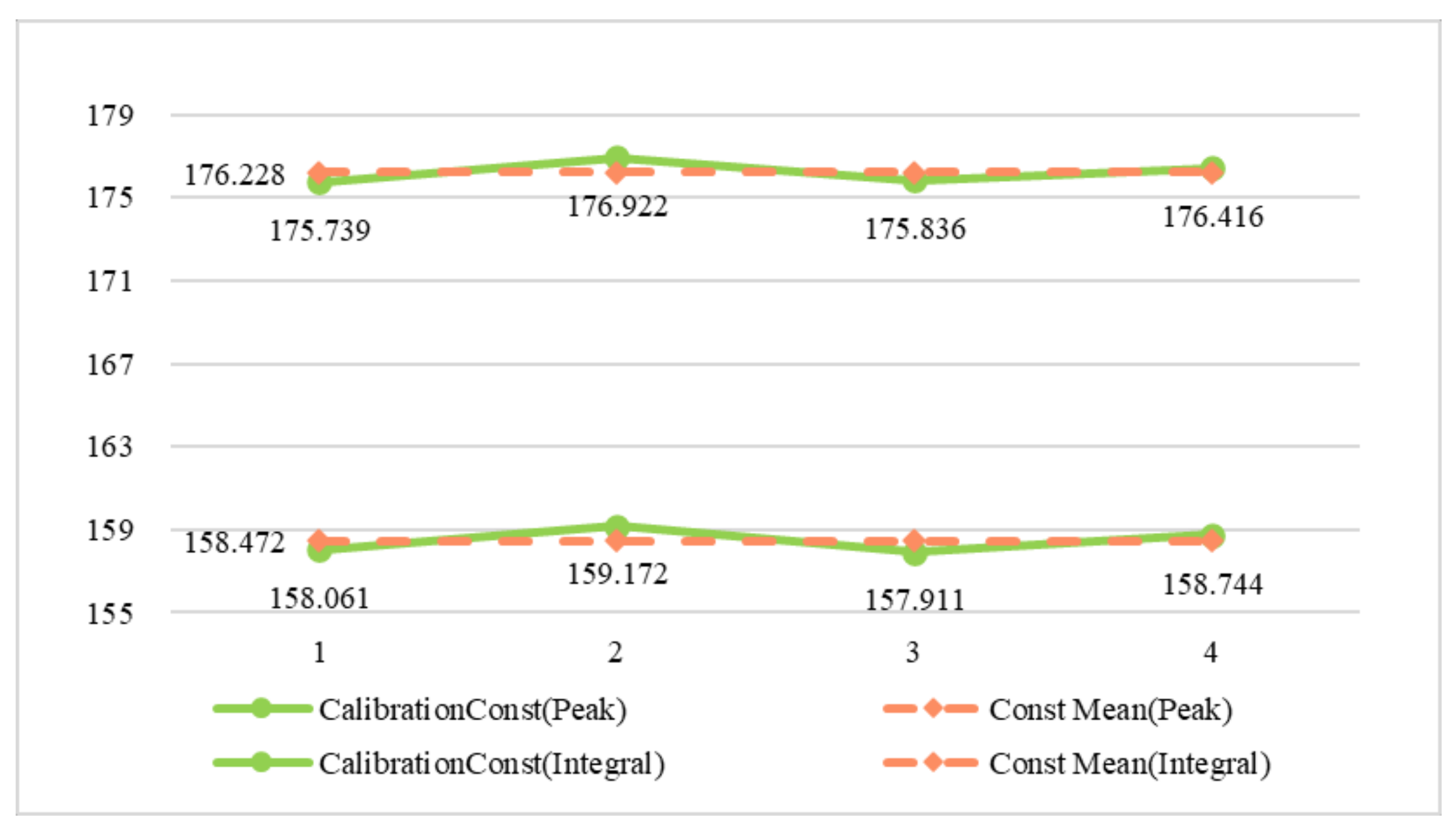

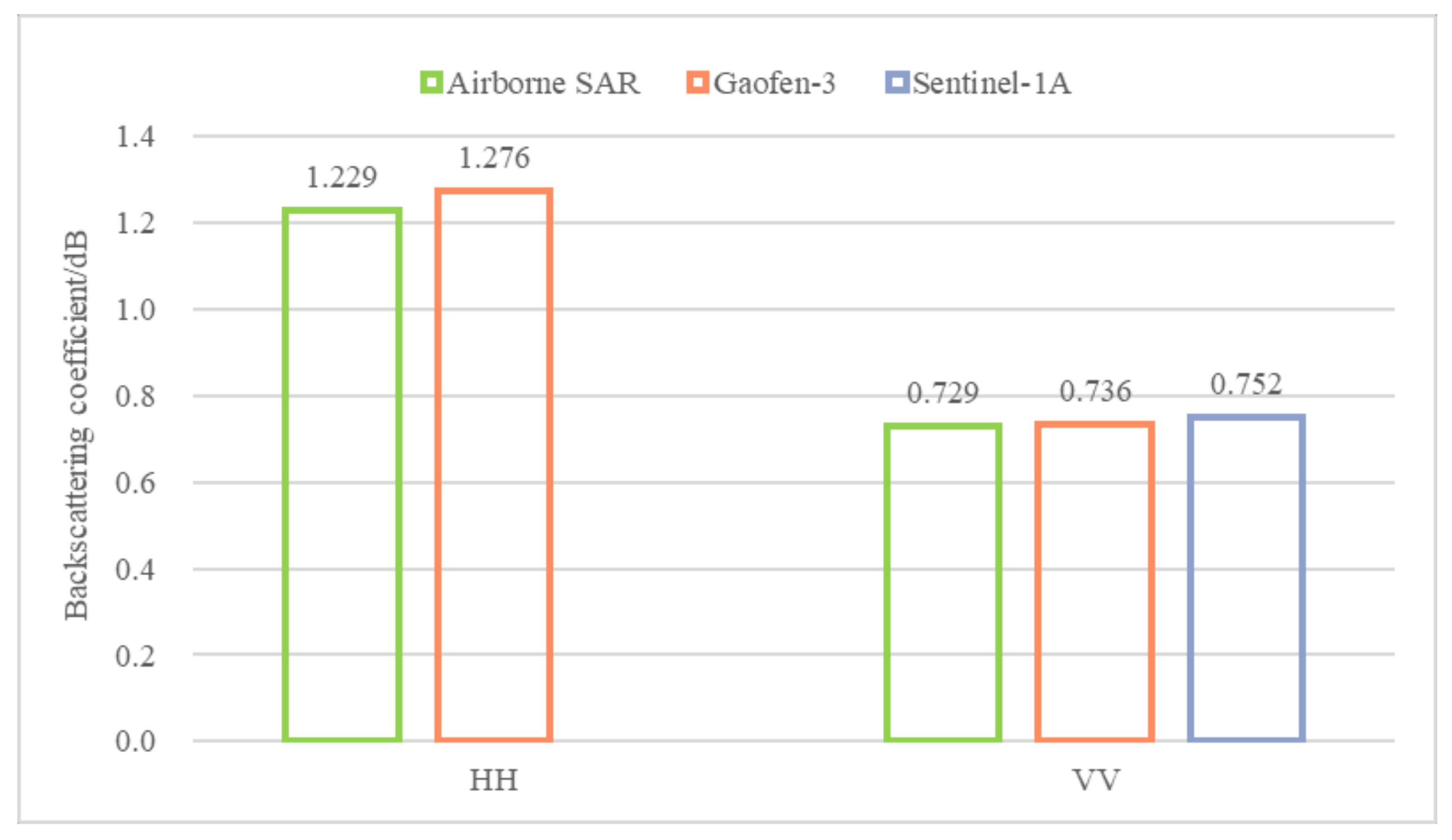
| Band | P | L | C | X |
|---|---|---|---|---|
| Center frequency/GHz | 0.45 | 1.25 | 5.4 | 9.6 |
| Type of polarization | VV&VH | AHV | AHV | AHV |
| Range resolution/m | 3.0 | 3.0–5.0 | 2.0–3.0 | 0.3–3.0 |
| Azimuth resolution/m | 3.0 | 3.0–5.0 | 2.0–3.0 | 2.0–3.0 |
| Height accuracy/m | 3–6 | — | — | 1–3 |
| Geometrical and radiometric accuracy | Can satisfy feature classification requirements | |||
| Sensor Parameter | C-SAR | Image Parameters | Content |
|---|---|---|---|
| Field of view (FOV) | 35–55° Left | Radar frequency/GHz | 5.4 |
| Relative altitude/m | 4500 | Type of polarization | Full polarization |
| Resolution/m | 0.5 | Range pixel space/m | 0.20 |
| Bandwidth/km | 3.3 (Antenna) | Azimuth pixel space/m | 0.14 |
| Route Offset/km | 3.2 | Center incidence angle/° | 53.65° |
| Sensor | Gaofen-3 | Sentinel-1A |
|---|---|---|
| Imaging Time | 22 November 2019 15:52:24 | 25 November 2019 16:01:48 |
| Band | C | C |
| Center frequency/GHz | 5.400 | 5.405 |
| Imaging Mode | QPSI | IW |
| Resolution/m | 8 | 20 |
| Range spacing/m | 2.248 | 2.330 |
| Azimuth spacing/m | 4.849 | 13.932 |
| Type of polarization | Quad | VV&VH |
| Direction | Ascending | Ascending |
| Incidence angle/° | 25.37~28.02 | 41.49~45.90 |
| Corner Reflector | Peak Method | Integral Method | ||||
|---|---|---|---|---|---|---|
| Measured Energy/dB | Mean/dB | Standard Deviation/dB | Measured Energy/dB | Mean/dB | Standard Deviation/dB | |
| CR01 | 183.197 | 183.609 | 0.591 | 200.875 | 201.365 | 0.551 |
| CR02 | 184.308 | 202.059 | ||||
| CR03 | 183.048 | 200.972 | ||||
| CR04 | 183.881 | 201.552 | ||||
| Corner Reflector | Longitude | Latitude | X-Coordinate | Y-Coordinate | SCR/dB |
|---|---|---|---|---|---|
| CR01 | 118.898 | 37.680 | 5574 | 7905 | 37.768 |
| CR02 | 118.895 | 37.685 | 7680 | 7332 | 37.305 |
| CR03 | 118.893 | 37.690 | 10,064 | 7864 | 37.175 |
| CR04 | 118.889 | 37.695 | 12,494 | 7145 | 40.255 |
| Mean SCR/dB | 38.126 | ||||
| Corner Reflector | Length/mm | Theoretical RCS/dBsm | Peak Method | Integral Method | ||
|---|---|---|---|---|---|---|
| Response Energy/dB | Constant/dB | Response Energy/dB | Constant/dB | |||
| CR01 | 700 | 25.136 | 183.197 | 158.061 | 200.875 | 175.739 |
| CR02 | 700 | 25.136 | 184.308 | 159.172 | 202.059 | 176.922 |
| CR03 | 700 | 25.136 | 183.048 | 157.911 | 200.972 | 175.836 |
| CR04 | 700 | 25.136 | 183.881 | 158.744 | 201.552 | 176.416 |
| Mean response energy | 183.609 | 201.365 | ||||
| Mean calibration constants | 158.472 | 176.228 | ||||
| Standard deviation of calibration constants | 0.591 | 0.551 | ||||
| Corner Reflector | Theoretical RCS/dBsm | Peak Method | Integral Method | ||
|---|---|---|---|---|---|
| Measured RCS/dBsm | Difference/dBsm | Measured RCS/dBsm | Difference/dBsm | ||
| CR01 | 25.136 | 24.694 | −0.442 | 24.621 | −0.515 |
| CR02 | 25.136 | 25.806 | 0.67 | 25.804 | 0.668 |
| CR03 | 25.136 | 24.545 | −0.591 | 24.717 | −0.419 |
| CR04 | 25.136 | 25.378 | 0.242 | 25.297 | 0.161 |
| Relative calibration accuracy | 0.591 | 0.551 | |||
| Absolute calibration accuracy | 0.670 | 0.668 | |||
| Corner Reflector | Longitude | Latitude | Maximum Center Method | Sliding Window Method | ||||
|---|---|---|---|---|---|---|---|---|
| X | Y | SCR/dB | X | Y | SCR/dB | |||
| CR01 | 118.898 | 37.680 | 5574 | 7905 | 37.768 | 5573 | 7905 | 37.784 |
| CR02 | 118.895 | 37.685 | 7680 | 7332 | 37.305 | 7680 | 7332 | 37.305 |
| CR03 | 118.893 | 37.690 | 10,064 | 7864 | 37.175 | 10,063 | 7864 | 37.188 |
| CR04 | 118.889 | 37.695 | 12,494 | 7145 | 40.255 | 12,494 | 7145 | 40.255 |
| Mean SCR | 38.126 | 38.130 | ||||||
| Corner Reflector | Length/mm | Theoretical RCS/dBsm | Maximum Center Method | Sliding Window Method | ||
|---|---|---|---|---|---|---|
| Response Energy/dB | Constant/dB | Response Energy/dB | Constant/dB | |||
| CR01 | 700 | 25.136 | 200.875 | 175.739 | 200.894 | 175.757 |
| CR02 | 700 | 25.136 | 202.059 | 176.922 | 202.068 | 176.932 |
| CR03 | 700 | 25.136 | 200.972 | 175.836 | 200.991 | 175.855 |
| CR04 | 700 | 25.136 | 201.552 | 176.416 | 201.561 | 176.424 |
| Mean response energy | 201.365 | 201.379 | ||||
| Mean calibration constants | 176.228 | 176.242 | ||||
| Standard deviation of calibration constants | 0.551 | 0.546 | ||||
| Corner Reflector | Theoretical RCS/dBsm | Maximum Center Method | Sliding Window Method | ||
|---|---|---|---|---|---|
| Measured RCS/dBsm | Difference/dBsm | Measured RCS/dBsm | Difference/dBsm | ||
| CR01 | 25.136 | 24.621 | −0.515 | 24.624 | –0.512 |
| CR02 | 25.136 | 25.804 | 0.668 | 25.800 | 0.664 |
| CR03 | 25.136 | 24.717 | −0.419 | 24.723 | –0.413 |
| CR04 | 25.136 | 25.297 | 0.161 | 25.293 | 0.157 |
| Relative calibration accuracy | 0.551 | 0.546 | |||
| Absolute calibration accuracy | 0.668 | 0.664 | |||
| Sensors | HH Polarization | VV Polarization |
|---|---|---|
| Airborne SAR | 1.229 | 0.729 |
| Gaofen-3 | 1.276 | 0.736 |
| Sentinel-1A | — | 0.752 |
Publisher’s Note: MDPI stays neutral with regard to jurisdictional claims in published maps and institutional affiliations. |
© 2022 by the authors. Licensee MDPI, Basel, Switzerland. This article is an open access article distributed under the terms and conditions of the Creative Commons Attribution (CC BY) license (https://creativecommons.org/licenses/by/4.0/).
Share and Cite
Li, L.; Zhang, F.; Shao, Y.; Wei, Q.; Huang, Q.; Jiao, Y. Airborne SAR Radiometric Calibration Based on Improved Sliding Window Integral Method. Sensors 2022, 22, 320. https://doi.org/10.3390/s22010320
Li L, Zhang F, Shao Y, Wei Q, Huang Q, Jiao Y. Airborne SAR Radiometric Calibration Based on Improved Sliding Window Integral Method. Sensors. 2022; 22(1):320. https://doi.org/10.3390/s22010320
Chicago/Turabian StyleLi, Lu, Fengli Zhang, Yun Shao, Qiufang Wei, Qiqi Huang, and Yanan Jiao. 2022. "Airborne SAR Radiometric Calibration Based on Improved Sliding Window Integral Method" Sensors 22, no. 1: 320. https://doi.org/10.3390/s22010320






